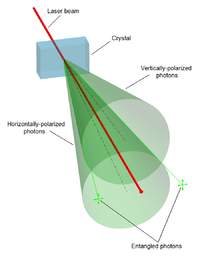
Photo from wikipedia
Quantum theory and relativity offer different conceptions of time. To explore the conflict between them, we study a quantum version of the light-clock commonly used to illustrate relativistic time dilation.… Click to show full abstract
Quantum theory and relativity offer different conceptions of time. To explore the conflict between them, we study a quantum version of the light-clock commonly used to illustrate relativistic time dilation. This semiclassical model combines elements of both theories. We show for Gaussian states of the light field that the clock time is independent of the initial state. We calculate the discrepancy between two such clocks when one is held in a gravitational field and the other is left to fall a certain distance. Contrasting our results with the case of pointlike observers in general relativity, as well as classical light-clocks, we find both quantitative and qualitative differences. We find that the quantum contribution to the discrepancy between the two clocks increases with the gravitational field strength, and results in a minimum resolution of the dropped clock (distinct from the quantum uncertainty in its measurement).
Journal Title: Classical and Quantum Gravity
Year Published: 2019
Link to full text (if available)
Share on Social Media: Sign Up to like & get
recommendations!